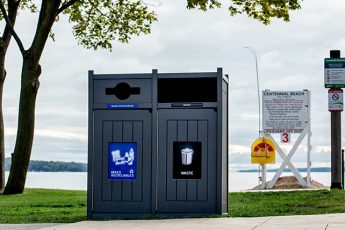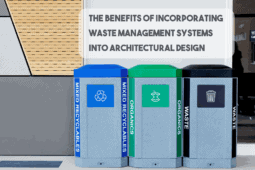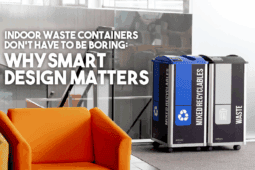
May 22, 2020 By Tim No Comments
The Positive Impacts of Creating a Successful Waste Management Program within your Architectural Design
For more information on how to build an exceptional recycling program in your next architectural design, click here.
In recent years, the architectural world has increasingly embraced eco-friendly and “zero-waste” approaches. As designers face mounting pressure to innovate sustainably, one highly effective strategy is integrating waste-management programs into building designs. Many architects are already doing this: introducing advanced recycling streams, organics collection, and clear, standardized systems for users. Doing so not only enhances a building’s functionality, but also its reputation and environmental performance.
Here are the three big areas where a strong waste-management program adds real value.
Economic Benefits
Budget often drives decisions in architecture and building management — so why invest in an advanced waste-management system? Because it pays back.
-
Lower waste-removal costs. In high-density cities or remote areas, trash removal can cost a lot. By diverting paper, plastic, and other recyclables from the waste stream, buildings can cut disposal bills by up to 50%. Of course, costs vary, and recycling collection does incur charges — but reducing the volume of traditional waste often brings net savings.
-
Stimulating the economy. Recycling isn’t just good for the planet: it supports jobs. A study by Waste Wise found that recycling creates jobs and saves money for institutions and governments alike.
-
Revenue from recycled materials. Many recyclable materials still have value. Selling or re-using them promotes a circular economy and can generate cost savings for clients or building owners.
-
Cleaner grounds. Offering clear waste and recycling options makes it easier for visitors and staff to dispose of trash properly. That reduces litter, improves aesthetics, and lowers maintenance costs.
Social Benefits
Beyond dollars, designing for waste management sends a strong message.
-
Encouraging recycling and organic waste collection signals that your design team cares about the environment.
-
When a building demonstrates green values, it can inspire visitors and employees to act more sustainably in their personal lives.
-
Recycling-related industries create jobs — for example, sorting and processing recyclables employ significantly more people than traditional waste-disposal firms.
-
Buildings that visibly promote recycling influence behaviour. When people see well-designed waste receptacles and clean spaces, they’re more likely to use them properly.
Environmental Benefits
This is perhaps the most obvious — but also the most profound — benefit of integrating a robust waste-management program into building design.
-
Recycling reduces pollution. Plastics and other materials in landfills release harmful chemicals and greenhouse gases; keeping them out of the waste stream cuts that burden.
-
Reusing materials reduces demand for raw materials, preserving natural habitats (like rainforests) and supporting biodiversity.
-
Manufacturing from raw materials typically uses much more energy than recycling. By lowering that energy demand, buildings can have a smaller carbon footprint.
-
Including organics collection adds substantial climate benefits:
-
It reduces methane emissions — a greenhouse gas about 21 times more potent than CO₂.
-
It minimizes leachate (toxic runoff) that threatens soil and water.
-
It returns nutrients to the soil, boosting soil health, improving water retention, and reducing the need for chemical fertilizers.
-
When architects incorporate thoughtful waste-management strategies, they aren’t just designing a building — they’re creating a symbol of responsible stewardship. These designs influence not only the building’s users, but also the broader architectural community and the communities in which buildings sit. Even small changes can ripple outward, encouraging better habits and raising standards across the board.
—
Now that we’ve filled you in on the quick list of benefits, we’re confident that you will find further success in your own program improvements, and when you do, we hope you share it with us! We would love to hear your challenges, successes, and any other industry knowledge that you have to share so that we can continue to educate and update our resources for you and other architects in the future.
Key Takeaways (TL;DR)
-
Integrating a comprehensive waste-management program into building design offers economic, social, and environmental benefits.
-
Economically: Lower disposal costs, generate value from recyclables, improve site cleanliness.
-
Socially: Signals environmental commitment, spurs jobs, influences behaviour and culture.
-
Environmentally: Reduces pollution and resource use, curbs methane emissions, strengthens ecosystem health.
-
For architects and building owners: These programs offer real, measurable returns — and help position your building (or your brand) as a leader in sustainable design.







